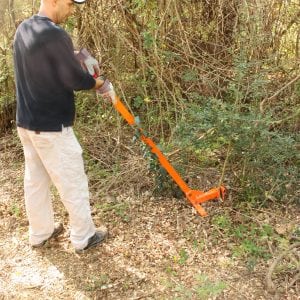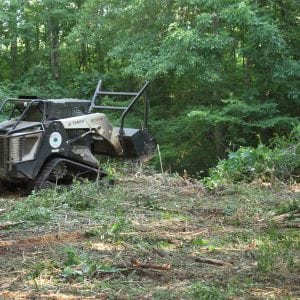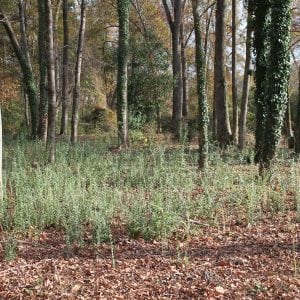Forestry & Wildlife

Chinese privet (Ligustrum sinense) and other invasive privets in the genus Ligustrum are a serious problem for many homeowners, farmers, foresters, and land managers in Alabama.
Privet control often seems impossible because of its aggressive growth, prolific root and stump sprouting, copious seed production, and widespread seed dispersal by birds and other animals. However, with the correct approach and diligent follow-up treatments, privet can be effectively controlled.
The following recommendations for widely available privet control options can be used across a range of land management scenarios. This is not, however, exhaustive as certain herbicides used in forestry and rights-of-way are not covered.
Identification
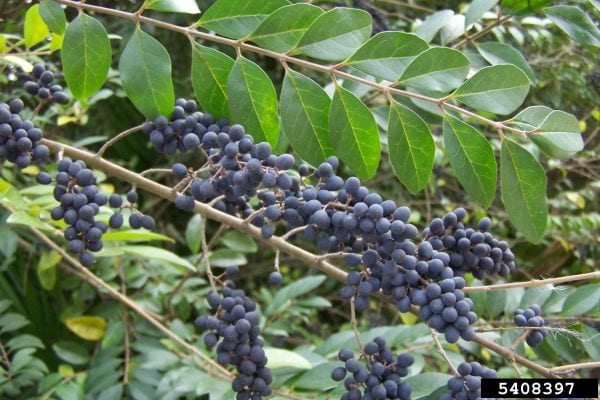
Figure 1. Chinese privet is a woody shrub with opposite leaves that remain green throughout the winter and with dark blue fruit that ripens in the fall. (Photo by Karan A. Rawlins, University of Georgia, Bugwood.org)
Chinese privet is a semievergreen to evergreen medium-sized shrub or small tree that can reach up to 30 feet in height. It has oval-shaped, lustrous green leaves that occur opposite one another in two rows along stems. Leaves range in size from 0.75 to 1.5 inches long and 0.4 to 1.2 inches wide. The light gray to brownish bark is thin and smooth with scattered lenticels (small dots). Plants produce an abundance of fragrant white flowers from April to June. These mature into dense elliptical drupes about 0.2 inches in diameter that are pale green in the summer and ripen to dark purple to black in late fall.
Japanese privet (Ligustrum japonicum) and glossy privet (L. lucidum) are small evergreen trees ranging from 20 to 40 feet. Leaves are opposite, but significantly larger (1.5 to 4 inches long) and more leathery than Chinese privet. Bark, flowers, and fruit are similar to those of Chinese privet.
Hand Pulling
Hand pulling is a good option for privet seedlings and small saplings. It can be done any time of year but is easiest when soils are moist. Grab the base of the privet stem with your fingers or a pair of pliers and pull upward, trying to remove as much of the roots as possible. If the plant does not come up easily, it might be a sprout from a lateral root, and hand pulling will not work.
Weed Wrenching
Weed wrenches are effective for removing privet saplings up to 2 inches in diameter. Weed wrenches are handheld steel tools that grasp woody stems at the base and use leverage to lift the plant out of the ground (figure 2). They work best for single-stemmed plants but can also be used for some multistemmed clumps. Because privet has a shallow fibrous root system, pulling may severely disturb the soil and is not recommended along stream banks or steeply sloped areas where erosion may occur.
Hand Cutting
Cutting, when used alone, does not provide satisfactory control because of rapid stump sprouting. However, it can be used with cut stump or foliar herbicide treatments described below.
- Figure 2. A weed wrench uses leverage to easily lift privet saplings out of the ground.
- Figure 3. Skid steer mulchers can quickly grind dense stands of privet to the ground.
- Figure 4. Following mulching or other mechanical treatments, privet rapidly sprouts from stumps and lateral roots. This creates a good setup for a late fall foliar treatment with the herbicide glyphosate.
Brush Mulching and Mowing
Brush mulchers (figure 3) are typically mounted on skid steers and grind or mulch entire shrubs and small trees. They quickly remove dense stands of privet, providing immediate access to an area. Most brush mulchers can mulch all sizes of privet and often leave a thick mulch layer. Mowing can also minimize dense stands, but this method is limited to small trunk diameters when using typical tractor equipment and rotary mowers. They do not remove the root system, and sprouting will inevitably occur (figure 4). Brush mulching cannot be effectively integrated with cut stump treatment because stumps will be buried under the mulch layer. However, brush mulching often results in uniform privet regrowth that can easily be sprayed. Brush mulching can be used anytime but may spread privet seed if used in the fall.
Herbicide Treatment
Privet can be effectively controlled with foliar, cut stump, and basal bark herbicide treatments. Hack and squirt treatments can be used in some situations. Always read and follow the herbicide label, paying attention to site and rate restrictions and safety recommendations for applicators.
Foliar Herbicide Treatment
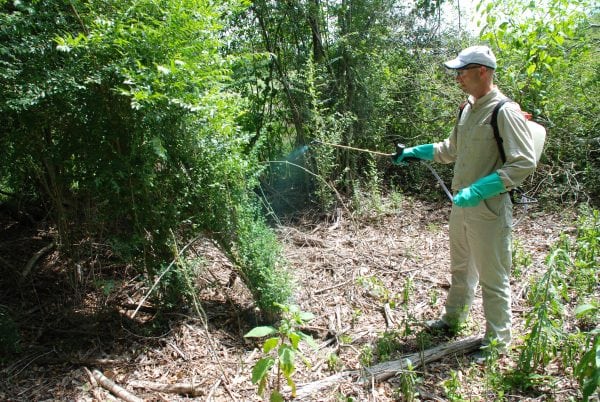
Figure 5. A blue spray indicator or dye improves spray visibility for the applicator.
Spot treatments to the foliage can be applied with several types of sprayers, but single nozzle backpack sprayers are used in many situations (figure 5). Spray the foliage to wet, but not to the point of runoff. Good spray coverage over the entire plant is important as privet shrubs sprayed only on the sides will not be completely killed. If the privet is taller than 6 to 8 feet, consider using other methods such as brush mulching, basal bark, or cut stump treatment. Broadcast herbicide applications applied to foliage can be effective if you are treating large areas where a spray boom can effectively reach over the top of the privet canopy.
For many situations, herbicides with the active ingredient glyphosate are the most effective option. However, not all glyphosate products are created equally. They can vary in concentration of the active ingredient and may or may not include a surfactant, which improves absorption into the leaves. Use a concentrate-type product with at least 41 percent glyphosate. Do not use glyphosate formulations called “Ready to Use” because they generally do not contain enough glyphosate to be effective. Mix the herbicide with water, preparing a 3 to 5 percent solution (4 to 6 fluid ounces of herbicide product per gallon). If the label recommends additional surfactant, add a nonionic surfactant at 0.5 percent (0.6 fluid ounces per gallon).
The optimal timing for glyphosate treatment is late fall to early winter (November through early January) when day temperatures are mild. However, do not treat during extended cold weather when temperatures are at or below freezing. This late-fall timing is advantageous as most other vegetation is dormant and will not be harmed by glyphosate. Glyphosate treatments applied in the spring and summer may not provide effective control, and the risk of damage to surrounding vegetation is much greater.
When applying glyphosate, volatility and soil activity are not a concern. Drift, however, can be a serious problem, especially on windy days. Be careful where spray drift can damage or kill nearby desirable vegetation. Additionally, when spraying along streams, ponds, and lakes where there is a risk of spray going into the water, use a glyphosate product and nonionic surfactant labeled for use in aquatic environments. Glyphosate products not labeled for use in or near water often contain a surfactant that may harm aquatic organisms.
If privet populations occur in forage pastures or hayfields, Remedy Ultra or Vastlan may be broadcast- applied at 2 quarts per acre or in a 2 percent volume per volume (v/v) solution with at least 20 gallons of water per acre (GPA) output. Higher output volume allows the herbicide to penetrate farther into thick foliage canopies. This treatment is most effective when applied from summer to fall.
Cut Stump Herbicide Treatment
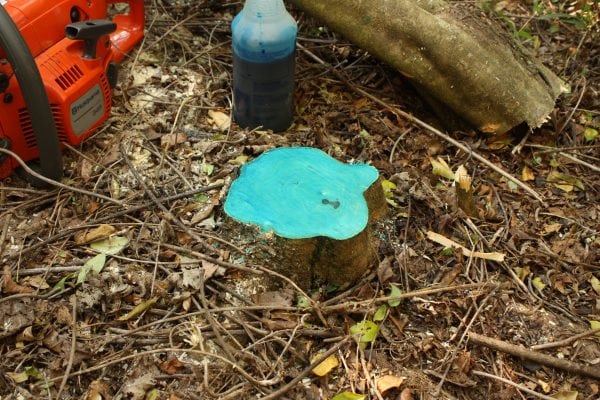
Figure 6. Spray to wet the entire surface of small stumps. A spray indicator helps keep track of what has been treated.
This method entails cutting followed by the application of an herbicide to the surface of the stump. For best results, cut privet stems close to the ground and remove any sawdust from the stump. Then, within a few minutes at most, spray or paint the cut surface with the herbicide solution (figure 6). The most critical area of the stump to spray is just inside the bark or about 2 inches around the entire circumference. For smaller stems, it is often easier to treat the entire stem. Spray to wet, but do not puddle the herbicide around the stump. Use an herbicide concentrate product with either 41 percent or higher active ingredient glyphosate or 44 percent active ingredient triclopyr amine. Mix the herbicide with water, preparing a 25 percent solution (32 fluid ounces of herbicide product per gallon).
Herbicide products with lower concentrations of glyphosate or triclopyr amine are available. These types of “brush killer” products should be applied to stumps at full strength. Avoid formulations with concentrations with less than ~20 percent glyphosate or 8 percent triclopyr amine, as they do not contain enough herbicide to be effective.
If the herbicide treatment must be delayed following cutting, a different approach must be used. Within a few weeks of cutting, use a triclopyr ester herbicide product mixed with oil instead of water. Mix the herbicide with an oil carrier such as bark oil or diesel, preparing a 20 percent solution (26 fluid ounces of herbicide product per gallon). There is also a triclopyr ester ready-to-use product with no mixing required. Spray the entire surface and sides of the stump.
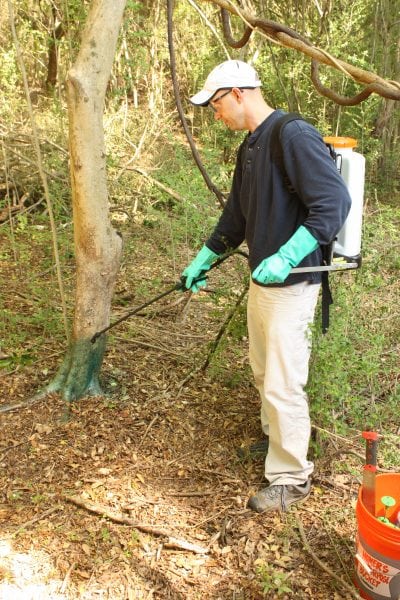
Figure 7. Chinese privet is thin barked and even large-diameter shrubs can be controlled with the basal bark treatment method.
Both water- and oil-based cut stump treatments work on any size privet, but it is critical to treat every cut stem. Untreated cut stems will sprout. Cut stump treatments can be done almost any time of year, but late fall is the easiest from an operational standpoint. The only time cut stump treatments should not be done is in the early spring when privet shrubs are experiencing strong upward sap flow. This is evident when stumps appear to “bleed” water following cutting.
Basal Bark Herbicide Treatment
Basil bark herbicide treatment entails spraying the entire circumference of the bottom 12 to 18 inches of each stem with an oil-soluble herbicide (figure 7). Because privet is thin barked, even large-diameter shrubs can be effectively controlled with this approach. Use a triclopyr ester (e.g., Garlon 4 or Remedy Ultra) or triclopyr acid (Trycera) herbicide-formulated product. Mix the herbicide with an oil carrier such as bark oil or diesel, preparing a 20 percent solution (26 fluid ounces of herbicide product per gallon). There is also a triclopyr ester ready-to-use product with no mixing required. Spray to wet, getting complete coverage of each woody stem, but do not puddle the herbicide on the soil. Fall is generally the best time for this treatment, but it may be used any time of the year. This treatment may take a few months to kill privet, but it is effective. Triclopyr ester does have some soil activity, and damage to nontarget species can occur when numerous privet stems are treated in a small area.
In pastures or other areas where damage to surrounding vegetation (especially hardwood species) is not a concern, a 20 percent imazapyr solution (Arsenal or Polaris) can be used. This is not recommended for residential use due to the soil activity of imazapyr.
Hack-and-Squirt
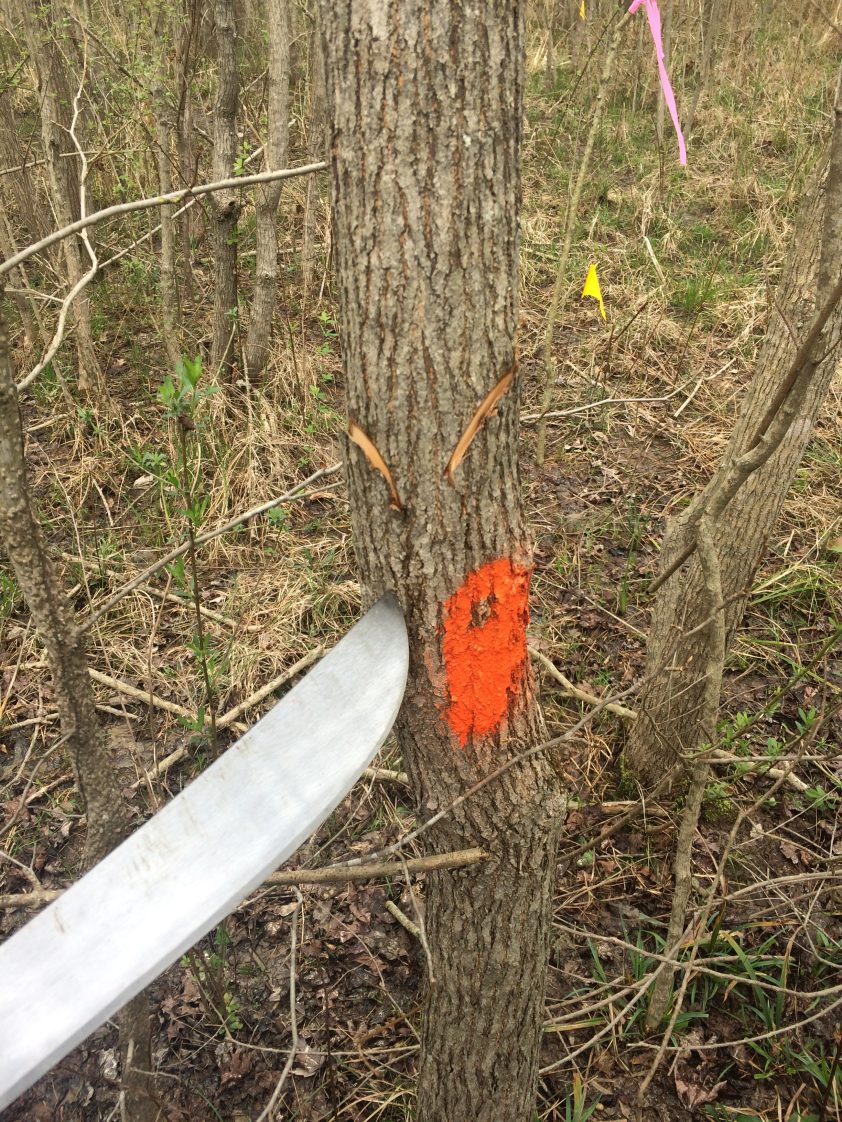
Figure 8. Fall is generally the best time for hack-and-quirt treatments.
Hack-and-squirt involves making incisions in the stem at a 45-degree angle for every 2 to 3 inches in stem diameter (figure 8). Squirt 1 ml of undiluted herbicide in each incision so that it comes in direct contact with the cambium layer. Several herbicides, including glyphosate, triclopyr amine, imazapyr, and aminocyclopyrachlor can be used. Fall is generally the best time for this treatment, but it may be used any time of the year. As with basal bark treatments, this treatment may take a few months to kill privet.
Realities of Privet Control
No single treatment will eradicate privet. There will almost always be a flush of new seedlings in the year following intensive control, especially along woodland edges. Some sprouting from lateral roots and stumps missed during initial treatment will also be inevitable. These seedlings and sprouts can be easily controlled with foliar glyphosate treatment, which is best done in the late fall. While privet seeds in the soil seed bank only survive for about 1 year, birds and flooding can reintroduce seed into the area. Follow-up monitoring and spot treatment of newly established plants should be done to prevent reinfestation.
Following privet control, many factors influence which species naturally recolonize the site. In addition to sunlight and moisture availability, these factors include surrounding vegetation and prior land use. To direct this process of recolonization and site restoration, land managers may choose to plant desired species actively. If replanting, continued monitoring and spot treatment of new privet are critical as there are no known plant communities in the southeastern United States that will completely resist privet invasion.
 Revised by Nancy Loewenstein, Extension Specialist, Forestry, Wildlife and Natural Resources Management; and David Russell, Assistant Extension Professor, Crop, Soil, and Environmental Sciences, both with Auburn University. Originally written by Stephen Enloe, former Extension Specialist; Nancy Loewenstein, Extension Specialist, Forestry, Wildlife and Natural Resources Management; and David Russell, Assistant Extension Professor, Crop, Soil, and Environmental Sciences, all with Auburn University.
Revised by Nancy Loewenstein, Extension Specialist, Forestry, Wildlife and Natural Resources Management; and David Russell, Assistant Extension Professor, Crop, Soil, and Environmental Sciences, both with Auburn University. Originally written by Stephen Enloe, former Extension Specialist; Nancy Loewenstein, Extension Specialist, Forestry, Wildlife and Natural Resources Management; and David Russell, Assistant Extension Professor, Crop, Soil, and Environmental Sciences, all with Auburn University.
Revised December 2023, Control Options for Chinese Privet, ANR-1468


